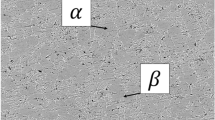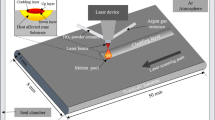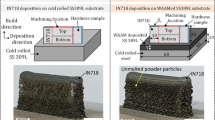Abstract
Due to high temperature strength (hot strength), excellent corrosion resistance and high strength-to-weight ratio, Ti-6Al-4V alloy is considered as a potential candidate for extensive applications in aerospace and biomedical engineering. But, alloy’s low thermal conductivity and extreme chemical affinity (towards tool substrate and coating materials) often cause an aggressive cutting environment with a tremendous rise in cutting zone temperature, premature tool wear, and disappointing surface integrity during conventional machining processes. In order to achieve desired machining yield without opting for any coolant, selection of proper cutting tool (based on their geometry and properties) is indeed vital. Thus, the present work examined the performance of MTCVD-TiCN-Al2O3-TiOCN multi-layer coated carbide and PVD TiN single layer coated composite ceramic (Al2O3/TiCN) tool inserts during dry machining of Ti-6Al-4V. Higher friction coefficient (of the coating system) was revealed for the ceramic tool which caused substantial temperature rise at tool-tip. On the other hand, carbide insert imparted lower cutting force (beyond \(v\) = 80 m/min) than ceramic insert due to its better thermo-chemical stability. Coating peel-off and tool flaking were witnessed for ceramic insert due to its thermal instability at higher cutting speeds; while carbide tool was mainly affected by material adhesion, abrasion, and chip fusion (adhesion of broken chip-fragments over tool surface due to high pressure and temperature). It was experienced that induced cutting heat significantly affected chip morphology under a dry cutting environment. Up to \(v\) = 130 m/min, ceramic tool exhibited lower flank wear than carbide tool.























Similar content being viewed by others
References
Ezugwu E O and Wang Z M 1997 Titanium alloys and their machinability—a review. J. Mater. Process. Technol. 68(3): 262–274
Niknam S A, Khettabi R and Songmene V 2014 Machinability and machining of titanium alloys: a review. In: Machining of Titanium Alloys (pp. 1-30). Springer, Berlin
Pervaiz S, Rashid A, Deiab I and Nicolescu M 2014 Influence of tool materials on machinability of titanium-and nickel-based alloys: a review. Mater. Manuf. Process. 29(3): 219–252
Klocke F and Eisenblatter G 1997 Keynote papers. Opening session of dry cutting. CIRP Ann. Manuf. Technol. 46(2): 519–526
Ezugwu E O 2004 High speed machining of aero-engine alloys. J. Braz. Soc. Mech. Sci. Eng. 26(1): 1–11
Khan M A, Mia M and Dhar N R 2017 High-pressure coolant on flank and rake surfaces of tool in turning of Ti-6Al-4V: investigations on forces, temperature, and chips. Int. J. Adv. Manuf. Technol. 90(5–8): 1977–1991
Revuru R S, Posinasetti N R, Venkata Ramana V S N and Amrita M 2017 Application of cutting fluids in machining of titanium alloys—a review. Int. J. Adv. Manuf. Technol. 91(5–8): 2477–2498
Wang Z M and Ezugwu E O 1997 Performance of PVD-coated carbide tools when machining Ti-6Al-4V. Tribol. Trans. 40(1): 81–86
Álvarez M, Gómez A, Salguero J, Batista M, Huerta M M and Marcos Bárcena M 2010 SOM-SEM-EDS identification of tool wear mechanisms in the dry-machining of aerospace titanium alloys. In: Advanced Materials Research (vol. 107, pp. 77-82). Trans Tech Publications Ltd
Srivastava A K and Iverson J 2010 An experimental investigation into the high speed turning of Ti-6Al-4V titanium alloy. In: Proc. of the ASME 2010 International Manufacturing Science and Engineering Conference. ASME 2010 International Manufacturing Science and Engineering Conference, vol. 1, Erie, Pennsylvania, USA. October 12–15, 2010. 401-408. ASME
Andriya N, Rao P V and Ghosh S 2012 Dry machining of Ti-6Al-4V using PVD coated TiAlN tools. In: Proceedings of the World Congress on Engineering of The 2012 International Conference of Manufacturing Engineering and Engineering Management (WCE’12, ICMEM), London, UK
Sharma A, Sharma M D and Sehgal R 2013 Experimental study of machining characteristics of titanium alloy (Ti–6Al–4V). Arab. J. Sci. Eng. 38(11): 3201–3209
Nouari M and Makich H 2013 Experimental investigation on the effect of the material microstructure on tool wear when machining hard titanium alloys: Ti–6Al–4V and Ti-555. Int. J. Refract. Met. Hard Mater. 41: 259–269
Chowdhury M S I, Chowdhury S, Yamamoto K, Beake B D, Bose B, Elfizy A, Cavelli D, Dosbaeva G, Aramesh M, Fox-Rabinovich G S and Veldhuis S C 2017 Wear behaviour of coated carbide tools during machining of Ti6Al4V aerospace alloy associated with strong built up edge formation. Surf. Coat. Technol. 313: 319–327
Byrne G, Dornfeld D and Denkena B 2003 Advancing utting technology. CIRP Ann. Manuf. Technol. 52(2): 483–507
Hosseini A, Kishawy H A and Davim J P 2014 Machining of titanium alloys. JP Davim, ed., Springer, Berlin/ Heidelberg, Germany
Luo S Y, Liao Y S and Tsai Y Y 1999 Wear characteristics in turning high hardness alloy steel by ceramic and CBN tools. J. Mater. Process. Technol. 88(1–3): 114–121
Benga G C and Abrao A M 2003 Turning of hardened 100Cr6 bearing steel with ceramic and PCBN cutting tools. J. Mater. Process. Technol. 143: 237–241
Sai W B, Zghal A and Ayed K B 2005 Carbide and ceramic tool life in high speed turning. Int. J. Veh. Des. 39(1–2): 140–153
Deshayes L, Evans J L, Ivester R, Bhat D G, Batzer S A and Whitenton E P 2005 Mechanical and thermal behavior for machining Ti-6Al-4V with AlMgB14 and WC-Co tools. In: ASME International Mechanical Engineering Congress and Exposition (vol. 42231, pp. 503-512), November 5–11, 2005, Orlando, Florida, USA
Xu C H, Feng Y M, Zhang R B, Zhao S K, Xiao X and Yu G T 2009 Wear behavior of Al2O3/Ti(C, N)/SiC new ceramic tool material when machining tool steel and cast iron. J. Mater. Process. Technol. 209: 4633–4637
Davim J P and Figueira L 2007 Machinability evaluation in hard turning of cold work tool steel (D2) with ceramic tools using statistical techniques. Mater. Des. 28(4): 1186–1191
Sarma D K and Dixit U S 2007 A comparison of dry and air-cooled turning of grey cast iron with mixed oxide ceramic tool. J. Mater. Process. Technol. 190(1–3): 160–172
Thamizhmanii S, Kamarudin K, Rahim E A, Saparudin A and Hassan S 2007 Tool wear and surface roughness in turning AISI 8620 using coated ceramic tool. In: Proceedings of the World Congress on Engineering, WCE 2007, London, UK, 2-4 July, 2007
Aslan E, Camuşcu N and Birgören B 2007 Design optimization of cutting parameters when turning hardened AISI 4140 steel (63 HRC) with Al2O3 + TiCN mixed ceramic tool. Mater. Des. 28(5): 1618–1622
Kamely M A, Noordin M Y, Ourdjini A, Venkatesh V C and Razali M M 2008 Alternative low cost cutting tools for hard turning of AISI D2. J. Adv. Manuf. Technol. 2(2): 29–37
Fnides B and Yallese M A 2008 Cutting forces and surface roughness in hard turning of hot work steel X38CrMoV5-1 using mixed ceramic. Mechanica 70(2): 73–78
Aslantas K, Ucun I and Cicek A 2012 Tool life and wear mechanism of coated and uncoated Al2O3/TiCN mixed ceramic tools in turning hardened alloy steel. Wear 274: 442–451
Amini S, Fatemi M H and Atefi R 2014 High speed turning of Inconel 718 using ceramic and carbide cutting tools. Arab. J. Sci. Eng. 39(3): 2323–2330
Shyha I, Gariani S and Bhatti M 2015 Investigation of cutting tools and working conditions effects when cutting Ti-6Al-4V using vegetable oil-based cutting fluids. Procedia Eng. 132: 577–584
Bensouilah H, Aouici H, Meddour I, Yallese M A, Mabrouki T and Girardin F 2016 Performance of coated and uncoated mixed ceramic tools in hard turning process. Measurement 82: 1–18
Wang D, Xue C, Cao Y and Zhao J 2017 Fabrication and cutting performance of an Al2O3/TiC/TiN ceramic cutting tool in turning of an ultra-high-strength steel. Int. J. Adv. Manuf. Technol. 91(5–8): 1967–1976
Tan D W, Guo W M, Wang H J, Lin H T and Wang C Y 2018 Cutting performance and wear mechanism of TiB2-B4C ceramic cutting tools in high speed turning of Ti6Al4V alloy. Ceram. Int. 44(13): 15495–15502
Nicolodi J H W, Consalter L A, Durán O and Souza A J 2019 Effect of wear progression in an’S’-type mixed ceramic tool on machining forces and surface roughness in the turning of hardened AISI 4140 steel. Int. J. Mach. Mach. Mater. 21(3): 228–243
Arunachalam R M, Mannan M A and Spowage A C 2004 Residual stress and surface roughness when facing age hardened Inconel 718 with CBN and ceramic cutting tools. Int. J. Mach. Tools Manuf. 44(9): 879–887
Chavoshi S Z and Tajdari M 2010 Surface roughness model-ling in hard turning operation of AISI 4140 using CBN cutting tool. Int. J. Mater. Form. 3(4): 233–239
Kato H and Komai K 2007 Tribofilm formation and mild wear by tribo-sintering of nanometer-sized oxide particles on rubbing steel surfaces. Wear 262(1–2): 36–41
Balaji A K and Mohan V S 2002 An ‘effective cutting tool thermal conductivity’ based model for tool–chip contact in machining with multi-layer coated cutting tools. Mach. Sci. Technol. Int. J. 6(3): 415–436
Das S R, Dhupal D and Kumar A 2015 Experimental investigation into machinability of hardened AISI 4140 steel using TiN coated ceramic tool. Measurement 62: 108–126
Klocke F and Krieg T 1999 Coated tools for metal cutting–features and applications. CIRP Ann. Manuf. Technol. 48(2): 515–525
Lim C Y H, Lim S C and Lee K S 1999 The performance of TiN-coated high speed steel tool inserts in turning. Tribol. Int. 32(7): 393–398
Hsieh J H, Tan A L K and Zeng X T 2006 Oxidation and wear behaviours of Ti-based thin films. Surf. Coat. Technol. 201(7): 4094–4098
Dobrzański L A, Pakuła D, Křiž A, Soković M and Kopač J 2006 Tribological properties of the PVD and CVD coatings deposited onto the nitride tool ceramics. J. Mater. Process. Technol. 175(1–3): 179–185
Çelik Y H, Kilickap E and Güney M 2017 Investigation of cutting parameters affecting on tool wear and surface roughness in dry turning of Ti-6Al-4V using CVD and PVD coated tools. J. Braz. Soc. Mech. Sci. Eng. 39: 2085–2093
Joshi S, Pawar P, Tewari A and Joshi S S 2014 Tool wear mechanisms in machining of three titanium alloys with increasing β-phase fraction. Proc. I Mech E, Part B: J. Eng. Manuf. 228(9): 1090-1103
Karpuschewski B, Schmidt K, Prilukova J, Beňo J, Maňková I and Hieu N T 2013 Influence of tool edge preparation on performance of ceramic tool inserts when hard turning. J. Mater. Process. Technol. 213(11): 1978–1988
Dureja J S, Gupta V K, Sharma V S and Dogra M 2010 Wear mechanisms of coated mixed-ceramic tools during finish hard turning of hot tool die steel. Proc. I Mech E, Part C: J. Mech. Eng. Sci. 224(1): 183-193
Zhang X, Zheng G, Cheng X, Xu R, Zhao G and Tian Y 2020 Fractal characteristics of chip morphology and tool wear in high-speed turning of Iron-based super alloy. Materials 13(4): 1020. https://doi.org/10.3390/ma13041020
Rajaguru J and Arunachalam N 2017 Coated tool performance in dry turning of super duplex stainless steel. Procedia Manuf. 10: 601–611
Lima F F, Sales W F, Costa E S, da Silva F J and Machado Á R 2017 Wear of ceramic tools when machining Inconel 751 using argon and oxygen as lubri-cooling atmospheres. Ceram. Int. 43(1): 677–685
Lotfi M, Farid A A and Soleimanimehr H 2015 The effect of chip breaker geometry on chip shape, bending moment, and cutting force: FE analysis and experimental study. Int. J. Adv. Manuf. Technol. 78(5–8): 917–925
Dargusch M S, Sun S, Kim J W, Li T, Trimby P and Cairney J 2018 Effect of tool wear evolution on chip formation during dry machining of Ti-6Al-4V alloy. Int. J. Mach. Tools Manuf. 126: 13–17
Zhang J F, Chen Z M, Feng P F and Xu W H 2013 The characteristics of titanium alloy chip-breaking by orthogonal cutting with a surface-textured cutting tool. In: Applied Mechanics and Materials (vol. 365, pp. 1235-1239). Trans Tech Publications Ltd
Joshi S, Tewari A and Joshi S 2013 Influence of preheating on chip segmentation and microstructure in orthogonal machining of Ti6Al4V. J. Manuf. Sci. Eng. 135(6): 061017
Zhang S, Li J, Zhu X and Lv H 2013 Saw-tooth chip formation and its effect on cutting force fluctuation in turning of Inconel 718. Int. J. Precis. Eng. Manuf. 14(6): 957–963
Sun J and Guo Y B 2008 A new multi-view approach to characterize 3D chip morphology and properties in end milling titanium Ti–6Al–4V. Int. J. Mach. Tools Manuf. 48(12–13): 1486–1494
Wagner V, Baili M and Dessein G 2015 The relationship between the cutting speed, tool wear, and chip formation during Ti-5553 dry cutting. Int. J. Adv. Manuf. Technol. 76(5–8): 893–912
Komanduri R and Hou Z B 2000 Thermal modeling of the metal cutting process: part I-temperature rise distribution due to shear plane heat source. Int. J. Mech. Sci. 42(9): 1715–1752
Zhan H, Zeng W, Wang G, Kent D and Dargusch M 2015 Microstructural characteristics of adiabatic shear localization in a metastable beta titanium alloy deformed at high strain rate and elevated temperatures. Mater. Charact. 102: 103–113
Website reference:
Author information
Authors and Affiliations
Corresponding author
Rights and permissions
About this article
Cite this article
Sahoo, S.P., Datta, S. Comparative experimental study on application feasibiility of MTCVD TiCN-Al2O3-TiOCN multi-layer coated carbide and PVD TiN single layer coated composite ceramic inserts during dry machining of Ti-6Al-4V. Sādhanā 47, 105 (2022). https://doi.org/10.1007/s12046-022-01880-9
Received:
Revised:
Accepted:
Published:
DOI: https://doi.org/10.1007/s12046-022-01880-9






